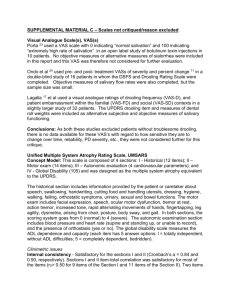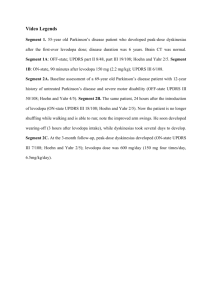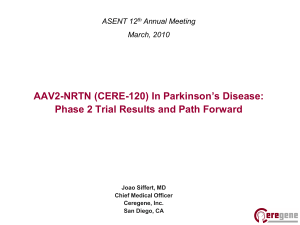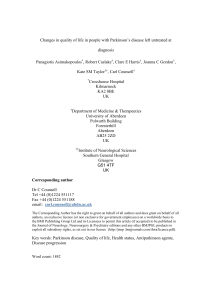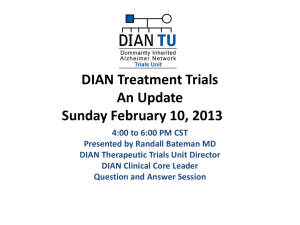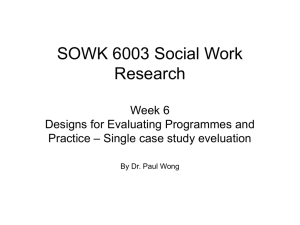Sample Size Estimation Incorporating Disease Progression
advertisement
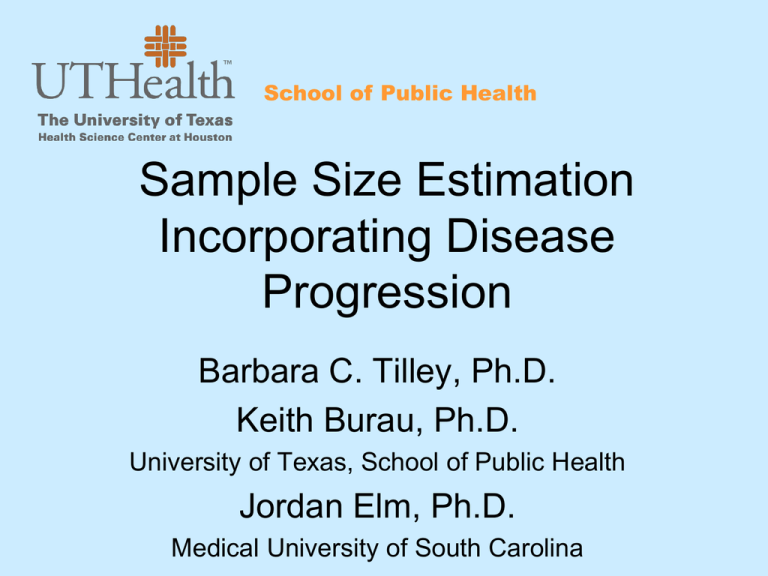
School of Public Health Sample Size Estimation Incorporating Disease Progression Barbara C. Tilley, Ph.D. Keith Burau, Ph.D. University of Texas, School of Public Health Jordan Elm, Ph.D. Medical University of South Carolina Acknowledgment This presentation is based on: Guimaraes P, Kieburtz K, Goetz CG, Elm JJ, Palesch Y, Huang P, Ravina B, Tanner CM, Tilley BC. Non-linearity of Parkinson’s disease progression: implications for sample size calculations in clinical trials. Clinical Trials 2005; 2:509-518 Parkinson’s Disease (PD) Issues • Many short term studies enroll untreated (de novo) patients. • De novo patients are followed to dopaminergic therapy and LOCF is used, or to study end point, whichever occurs first. • Once a patient starts dopaminergic therapy there is a decrease in the manifestions of PD. UPDRS scores • The gold standard PD rating scale • Measures combine questions on Motor, ADL, mental function • Purpose of Guimaraes et al’s approach was to characterize progression of UPDRS scores after initiation of symptomatic therapy UPDRS Scores Evolution of UPDRS Scores Start Sx Tx 3 - 6 months Time 5 years UPDRS Scores Long Term Follow-up of UPDRS scores with Different Study Populations Baseline End of Study STUDY TIME Sample Size Estimation • Based on data from other PD clinical trials (CALM-PD and GSK) we developed a non-linear model of the symptomatic effect of antiparkinsonian medications on disease progression as measured by UPDRS scores. • We used the model to: – Predict change in Total UPDRS; – Predict the variance (s.d.) associated with change in Total UPDRS; – To infer sample size Non-linear Model Yi(t) = b0i + b1it - b2i (1-eb3t) + it • The model assumes that scores reflect the sum of two components: • A linear trend reflecting disease progression • A symptomatic effect that “wears-off” over time Si(t)=b2i (1-eb3t) BASELINE = Initiation of Levodopa Estimated Changes in Total UPDRS (Based on CALM-PD data) Year 1 2 3 4 5 Change from Baseline -12.4 -9.6 -6.9 -4.1 -1.4 30% Change from Baseline* -3.7 -2.9 -2.1 -1.2 -0.4 Standard Deviation of Total Change 10.22 11.52 13.83 16.75 20.00 * 30% or 3 points change in UPDRS over over 1 yr = success BASELINE = Initiation of Levodopa Sample-Size Requirements (Based on CALM-PD data)* Year 1 2 3 4 5 Alternative 1 (30% relative change) 160 338 940 3899 47657 Alternative 2 (3 point change) 245 311 448 657 935 * Assumes actual value used, not LOCF BASELINE = 6 months after Levodopa Estimated Changes in Total UPDRS (Based on CALM-PD data) Year 1 2 3 4 5 Estimates for Total UPDRS Change 30% Change Standard from from Deviation of Baseline Baseline Total Change 2.6 0.8 7.03 5.4 1.6 9.74 8.1 2.4 13.07 10.9 3.3 16.65 13.7 4.1 20.34 BASELINE = 6 months after Levodopa Sample-Size Requirements (Based on CALM-PD data)* Year 1 2 3 4 5 Alternative 1 (30% relative change) 1709 761 609 546 516 Alternative 2 (3 point change) 117 223 400 649 967 * Assumes actual value used, not LOCF. Another Issue in PD • Reduction in time from diagnosis to initiation of antiparkinson/dopaminergic therapy (due to clinical practice) is adding to difficulty of studying untreated (de novo) patients Kaplan-Meier curve of time from diagnosis to need for symptomatic therapy. 100 CoQ10 GPI-1485 Current Placebo Creatine Minocycline Prior Placebo DATATOP Placebo 90 80 70 60 50 40 30 20 10 0 0 1 2 3 4 Years from Diagnosis 5 6 14 Sample Size for NET-PD LS-1 • Objective: Determine if there is > 1 year * difference in slowing of clinical decline over 5-year period comparing creatine treated participants to placebo treated participants. • Inclusion: All participants currently on dopaminergics drugs at least 90 days but < 2 years *1.5 years for ambulatory capacity Sample Size • Calculations based on data collected in other studies for patients on dopaminergic treatment at least 90 days. • Clinical decline: change from baseline* over 5 years using a combination of 5 cognitive, physical, and quality of life measures combined into a single outcome and compared with a global statistical test (O’Brien Ranked Test). * Rankin – final value Improvement in Long Term Progression Statistical Test of •Global Ambulatory capacity • Ambulatory capacity (5 UPDRS Questions)* • Modified Rankin (functional disability scale) • Modified Rankin (functional disability scale) • PDQ-39 (Quality of Life) • PDQ-39 (Quality of Life) •• Schwab and England (ADL scale) Schwab and England (ADL scale) •• Symbol DigitModalities Modalities(measure (measureofof cognitive Symbol Digit cognitive impairment) impairment) *Target of dopaminergic medications LS-1 Sample Size (cont) • N= 860 per group • Power > 85% to detect a 1-1.5 year slowing of clinical decline in the treatment arm compared to control • Chose largest sample size for a single outcome • alpha = 0.05, 2-sided. • Adjusted for 20% drop-ins and drop-outs with inflation factor • Overall GST gives > 90% power Considerations in Long Term Study • Avoids using short term LOCF value for long term outcome • Avoids non-linearity issue identified by Guimaraes. • Objective is improvement in long-term clinical decline rather than distinguishing symptomatic from disease modification effects • Expected to take at least 5 years to see changes in outcomes other than UPDRS. Delayed Start Design for Chronic Disease Phase 1 Phase 2 Disease Mod. Effect A P A A 0 T Baseline 1 Time Point T 2 T 3 T 4 Delayed Start • Goal to separate symptomatic from disease modifying effects • Provides shorter follow-up on placebo • More assumptions (e.g. duration of symptomatic effect) • Can be affected by non-linearity if de novo patients included. • Sample size implications if placebo goes on treatment NET-PD FS-Zone Phase II Futility Study of Pioglitazone • Inclusion criteria – on stable dose of either 1 mg/day of rasagiline or 10mg/day of selegiline for 8 months before randomization. • Expected to remain on the fixed dose for the duration of the trial. • Sample size - 72 pt per group to detect a 3 point change in UPDRS, two-sided alpha = 0.15, power = 0.85. FS-ZONE • Baseline examination roughly coincides with the period in which the patient is experiencing the maximum symptomatic benefit of the concurrent antiparkinson medication. • Thus the nonlinearity characterized by Guimaraes et al 2005 is avoided. Considerations for Phase II Studies of Shorter Duration Starting de novo patients on antiparkinson therapy before trial will: – Reduce variability – Reduce potential confounding (of other antiparkinsonian meds) – Reduce missing data (patients dropping out to go on other treatments) – Increase likelihood of recruitment. Alzheimer’s Disease Report of the task force on designing clinical trials in early (predementia) AD (e-Pub ahead of print). Neurology 2011. Painful Joint Scores MIRA Joint Pain Score Treatment Groups Contrasting Past or de novo DMARD use Weeks of Follow Up Treatment * Nonlinear Model Fit to 48 weeks of Observations Conclusions • Parkinson’s Disease (PD) – Effects of l-dopa and other dopminergic therapies on decline, and course of PD, and Guimaraes model suggest considering the effect of dopaminergic therapy on decline is essential in the design, at least for UPDRS (standard outcome measure). Conclusions Continued • Early Alzheimer’s Disease – Shares some characteristics of PD in terms of decline – Figure presented does not address introduction of other therapies – Therapies such as Aracept and others that may slow or mask decline may create similar design issues. – It would be useful to model Alzheimer’s data using Guimaraes approach Conclusions Continued • Rheumatoid Arthritis (RA) – Course of disease more erratic due to flares, remissions – Immediate and long term effects of DMARDs vary – Trials usually require stable dose of prednisone, methotrexate as entry criteria. – More analyses of RA data sets with longer follow-up and stronger DMARDS would be of interest; effects on sample size less likely EXTRA SLIDES LS-1Sample Size (1-Yr Diff. in Progression) Measure 5 year chg. PDQ-39 Summary score Minimum Expected detectable Common Effect Source Placebo Difference SD Size mean in means 15 3 9 0.33 Olanow et al. 2004 Modified Rankin (final value) 2.2 0.2 1 0.20 FS1, FS2, and K. Shannon (unpublished) Schwab & England ADL 10 2 11 0.18 PEP/PEPX Kieburtz et al. 1994 Symbol-Digit Modalities Ambulatory Capacity 5.5 1.5 8.0 0.19 1.25 0.38 2.11 0.18 CALM-PD
